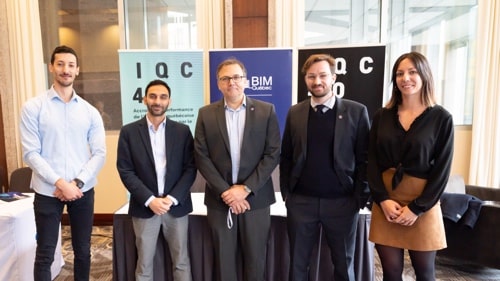
There is a wave of adoption coming. This was the bold statement from Ian Howell, Interim CEO of buildingSMART International, during the latest buildingSMART International Standards Summit and National Conference that was held in Montreal, Canada, at the Centre Mont-Royal between 18-21 October 2022.
This was the first in-person event in three years, and the theme was “Facilitating resilience in the built asset industry through international collaboration.” This focus on collaboration and working through challenging times is something the whole community has experienced over the last few years, and it was particularly poignant to be together again.
The Summit itself was hosted by the Canadian Chapter and Groupe BIM du Québec with a total of 33 sponsors and media partners. Autodesk and Dassault Systèmes were Event Platinum Partners with Bexel Consulting and Graitec as Gold Sponsors. ACCA software, Revizto, Pomerleau, NBS, SolidCAD, esri, Dalux and Graphisoft were Silver Sponsors and Magil Construction, ABCP Architecture, Blackware Technologies, GLT+, Groupe CANAM, EllisDon, HDR, Systra IBT, dRofus, Provencher_Roy, and SIMBIM Solutions were all Bronze Sponsors. Bentley Systems was the cocktail sponsor.

The event included an opening plenary day, the Canadian National Conference, two days of individual Room working sessions, awards presentations, the closing plenary, and gala dinner including the awards ceremony. Some of the key event highlights include:
- 769 total attendees (377 virtual)
- 150+ speakers over 4 days
- 84+ hours of presentations
- 24 sponsors
- 9 media partners
- Top 5 countries by attendance: Canada, United States, Hong Kong, Japan, Netherlands
- 1 board and 1 SAC meeting
- 9 award winners and 3 special mentions
It was undoubtedly a successful week. The first physical meeting in some time as the world finds a new norm. We were delighted to be able to provide a hybrid event for the first time, with virtual attendees able to be part of the event from around the world. The support from sponsors and media partners was unprecedented, and the openBIM Awards Program continues to show strong momentum an success. Following the sad loss of buildingSMART International’s CEO, Richard Petrie, in April 2022, this event is dedicated to his memory and many contributions.

The Opening Plenary - 18th October 2022
The opening plenary was hosted by Richard Kelly, Operations Director, buildingSMART International (bSI) and he welcomed Patrick MacLeamy, Chairman of bSI. They both remarked on the sad loss and extraordinary achievements of the late Richard Petrie, and his widow who attended as guest of honour for the week, Jane Petrie, was invited to the stage and presented ith a bouquet of flowers. Patrick also mentioned that the search for a replacement CEO is underway. Bill Moore, President of buildingSMART Canada and Martin Lafleur, General Director at Groupe BIM du Québec, both provided a welcome from the Canadian organizing committee. Their role in shaping the agenda and National Conference was key in bringing together a national and international audience to the openBIM agenda topic. Both shared some background to their organizations and some of the challenges facing the community.

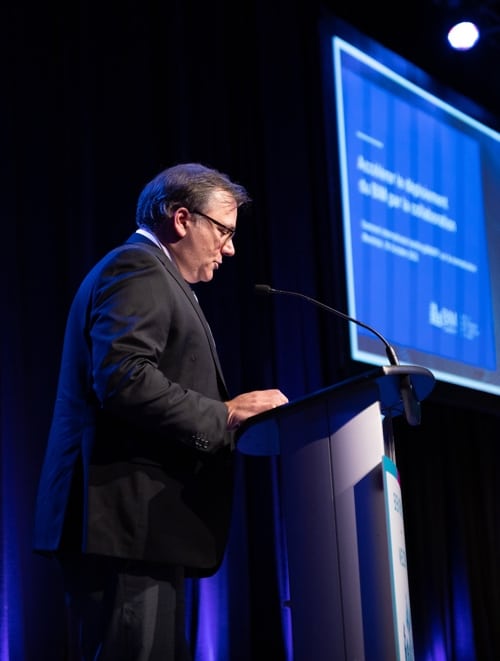
Next up was Ian Howell, Interim CEO of bSI, who began by sharing some of the latest achievements of bSI. This included new board members, new bSI members of staff, Technical Roadmap progress, and IFC 4.3 developments, as well as other items. Ian shared some planning and priorities for bSI, growth in areas such as Professional Certification, Room updates, and the new initiative of Accelerated Projects. Ian also warned of a wave of adoption that is coming, and the need for the industry to better collaborate and support certification, and that knowledge is critical. Richard welcomed Remi Dornier, Vice President, Architecture, Engineering, and Construction at Dassault Systèmes, who talked about a “Productization Approach” and the direction from Dassault Systèmes as a software vendor. Remi laid out the industry challenges, in particular their focus on sustainability as well as the ongoing commitment to buildingSMART. Finally, Marek Suchocki, Senior Global Business Development Executive at Autodesk Inc., provided a keynote on the support for openBIM at Autodesk. Marek showed how Autodesk has a long history with IFC and buildingSMART, dating back to its inception. Autodesk supports a range of activities, including plugins to support IFC 4.3 as well as principle sharing for openBIM.

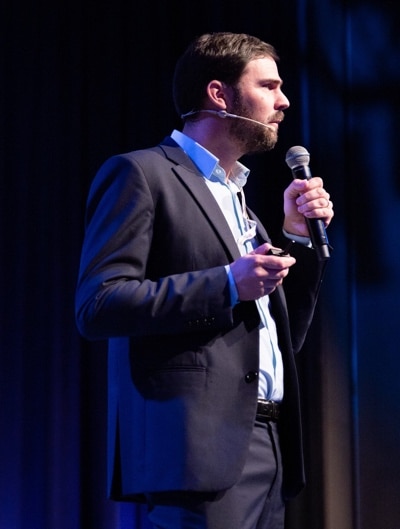

Sustainability and the Circular Economy
After the break, the focus turned to the topic of “Sustainability”. This session was hosted by Céline Bent, Compliance Director at bSI, who shared some insights into the topic. Céline talked about the role of compliance in relation to sustainability and how these two can be linked to help reduce waste and CO2 emissions, and to realize future efficiency gains. Céline’s expertise and passion for this topic was evident. This was followed by a presentation from Frank Hovorka, Chairman of buildingSMART France, who discussed the “Measurement of Carbon Reduction Goal: openBIM and Decarbonisation”. Frank’s presentation was also very compelling, providing the business case for measuring the amount of carbon produced by the construction industry. Frank touched on topics such as sustainable finance tied to development goals. Frank is advocating for the role of openBIM and how it is needed to deliver a global alignment of standards to meet and measure the CO2 output to benefit the planet. The next speaker was Trinidad Chardin-Segui, MEP Software CTO at Schneider Electric, who introduced the approach her company is taking in the topic of sustainability by applying their Normalized Electrical Model (NEM) as means to become an openBIM standard for electrical systems. The aim is for this standard to help with reducing waste by developing an electrical model and proposing a new calculation mode for the impact of emissions into the environment. Trinidad is also promoting the new Sustainable Energy Management Room which can be found in the closing plenary.



Following Trinidad was Chris Pyke, Senior Vice President Product at USGBC and Arc Skoru. Arc is part of the Green Building Council, which provides certification for the built asset industry. Chris explained that Arc measures, tracks, and scores buildings and spaces. Their goal is to try to push the industry to a net zero future, and this can be done by being “clean, efficient, electrified and grid responsive” through analytical performance improvements. Chris also provided an action plan for the future and proposed all assets should have specific targets to meet the global challenges. This approach of data-driven insights is seen as good opportunity for meeting future goals. After Chris was Catherine Dubois, Sustainable Development Advisor at Société Québécoise des infrastructures (SQI), who has published papers supporting her keynote on how we should build buildings and cities to address climate change. Catherine explored what climate change means for real estate managers and how open standards can help. She also shared a tool she has developed to address these challenges by using climatic data and other data models to analyze the climate. Both Catherine and Chris had tremendous overlap in terms of topic area with a common goal. Finally, Jugal Makwana, Global Director – Digital Engineering at Royal HaskoningDHV, provided his perspective and the goals RHDHV has as a business. In his presentation, Jugal outlined the need for collaboration, open standards, and project learning to inform the future. Based on his own extensive experience, and his role as a Board member of bSI, Jugal shared his vision for a better future. He states that these goals are achievable, but it requires good engineering data to address them. He also talked about the need to meet the sustainability goals of the UN as an imperative.


openBIM: Advancing Digital Workflows
This session was hosted and moderated by Léon van Berlo, Technical Director at bSI, who kicked off with a short presentation about some of the progress made and his personal journey during his time at bSI. Since its publication, the Technical Roadmap has made steady and significant progress which is well supported by other presenters in this session. Léon set up the session by focusing on the need for digital workflows in the openBIM ecosystem. The next presentation was from Min Song, Associate Director at Strategic Building Innovation, and Rick Klooster, Founder and CTO at Future Insight. They talked about Information Delivery Specifications (IDS) and the use case in Hong Kong, which added openBIM and openGIS as workflows to this new, soon to be standard. This use case is a city scale example, which is impressive. The benefits of this use case focus on the understanding for client requirements, bringing a repeatable process to the fore, and making it machine-readable at a city scale. Rick also shared an example from the City of Hague Project to show the ability to use the standard in other countries.


Following the IDS use case was a presentation from Stijn van Schaijk, BIM Process Manager at VolkerWessels, and Jan Brouwer, 3D Data Specialist at DigiBase, who started by declaring there would be a live demonstration of the buildingSMART Data Dictionary (bSDD). Their use of the bSDD, and the additional plugins that formed their research concluded that it added a lot of value to BIM models and helped to better structure data. The use of the bSDD and the requirements for VolkerWessels showcased the need for a good data structure and the need for access to national classification systems to add richness to the BIM data. This use case is seen as exemplary and important as it demonstrates the value of the new bSDD. Jan provided a live demonstration of the bSDD and how it was applied to the example cited. Next up was Frank Weiss, Senior Director New Products, BIM & Innovation at Oracle Construction and Engineering and René Schumann, Managing Director at HOCHTIEF ViCon, who presented “OpenCDE Doc API – Game changer for project management & more.” Firstly, Frank set out the context for the openCDE API project at bSI. This included the drivers and value of reducing steps for data exchange through API-driven CDE exchanges. Oracle has driven forward this project and always encouraged active participation from all other vendors to make it more effective. This approach was supported by René who shared HOCHTIEF ViCon’s approach to data management and data sharing. The openCDE API implementation has improved their ability to share BIM data from different sources and systems and helped to standardize their data processing to improve data visualization. The final presentation in this session was from David Ivey, Senior Design Technology Manager at HOK, who demonstrated the use of BIM Collaboration Format (BCF) in a design workflow. His demonstration showed how BCF is used at HOK and how it adds value to design reviews and issue resolution.


Global Perspectives: Strategies Driving International Activities
The final session of the opening keynotes was again expertly hosted by Richard Kelly, who began by providing context and progress from the solutions and standards program at bSI. Richard showed how, through interoperability and connected data, the industry could achieve its lofty goals and meet sustainable development goals. Connected data spans the entire value chain with real value to be had in good asset management. Richard also shared how bSI has progressed since its inception in 2014, from setting up the governance framework and Chapter network, through to integrating standards and services, and the community to user deployment as the final phase. This is of course always ongoing. There was also an overview of the progress of IFC 4.3 as it goes to ISO for official review and approval. After Richard was Casey Rutland, Director at digitalgreen.io, who provided a very clear overview of IFC and the benefits for a wider audience. Casey has long advocated for a broader adoption, and showed how IFC is beneficial for various communities and the potential if the industry understands its value. There was also a reveal for the relaunch of the entity that houses the UK&I Chapter, which is now known as "nima". The mission for nima is to support a more sustainable future for the industry by focusing on the value of information management. Next up was Michael Kennerly, Director of the Design Bureau at the Iowa Department of Transportation and a representative from AASHTO, The American Association of State Highway and Transportation Officials. Michael shared his perspective on why AASHTO passed a resolution to standardize on IFC and the value of being part of the community. He laid out some of the challenges ahead and was able to demonstrate the need for industry alignment and vendor support for the collection of DoTs in the US. He also stated that the key is open standards, a vision that was welcomed by the audience. It was announced that AASHTO will join bSI as a Principal Member, providing more collaboration and alignment opportunities.
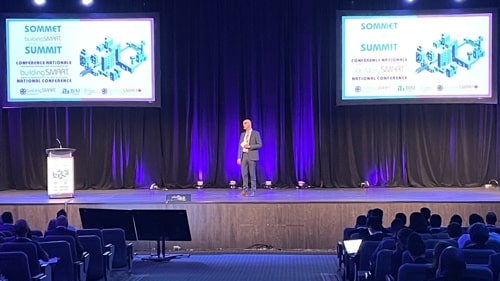

Adrian Wildenauer, Head of BIM Standards at Swiss Federal Railways SBB AG, was next to add further perspectives from a major client in Switzerland. SBB has been a pioneer in the area of openBIM, specifying it for works carried out in some of its contracts. Adrian shared the total investment from SBB in BIM because it is strategically important to them and it is clear they are fully committed. It helps SBB to have a full strategic lifecycle view of their business and the impact this has on passenger experiences. This focus on customer experience is why they believe in openBIM, because it allows the industry to align best practices and compatibility with other IT systems and a data ecosystem to make decisions better for their customers. Will Sharp, Senior Vice President at HDR, closed out the first day with a compelling presentation about why the US transportation industry is accelerating toward open standards. The crossover with Michael’s presentation was clear. Will shared that the desire for the industry is to get to the point where the model can be delivered as a legal document or as a contractual agreement. He shared a map of the US to show states that are already driving a model as a legal document and those that plan to. Will shared his experiences working with AASHTO and the BIM for Bridges initiative to shape his knowledge and belief in open data. HDR works closely with these industries providing expert advice and guidance with open standards at the core.
The day closed with a group photo and drinks provided by Cocktail Sponsor Bentley Systems.
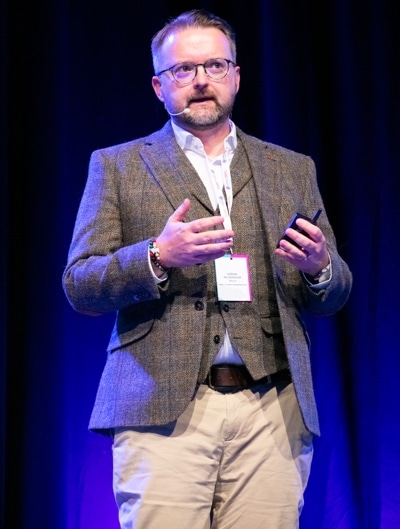

Days Two and Three – 19th and 20th October 2022
Days two and three followed a similar structure that offered attendees two options: The National Conference in the Symposia Theatre and individual buildingSMART Room sessions in breakout rooms. The National Conference had session topics such as “Governmental Strategies for BIM Adoption and Implementation,” “openBIM for Municipalities Across Canada”, “openBIM for Infrastructure and Transportation,” and “Enabling a National openBIM Digital Twin Ecosystem” with a variety of expert speakers assembled from around the globe. These sessions focused in on country-specific use cases as well as looking at the bigger opportunity with openBIM. The overall conclusion was very positive and credit to the buildingSMART Canada and Groupe BIM du Québec for developing such a comprehensive agenda.
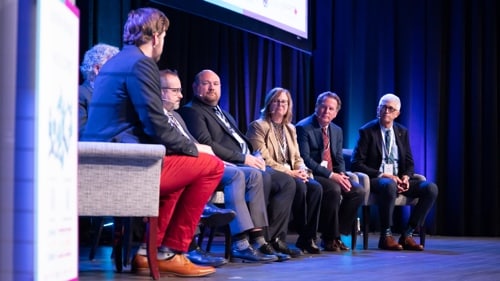

The buildingSMART Rooms consist of Airport, Building, Construction, Infrastructure, Product, Railway, Regulatory, Sustainable Energy Management and Technical. There were additional breakout rooms that hosted a number of general sessions covering a range of topics, as well as presentations from the finalists’ in the openBIM Awards Program that were open to all attendees. Virtual attendees were able to view and be part of all Room sessions and contribute in a new way that had not been possible at previous Summits. With a hugely wide range of topics discussed, each Room had its own program and agenda with roadmaps, project updates, activity proposals, open sessions, and hot topics, amongst other things. There was one consistent theme, however: more cross-collaboration was asked for with more opportunities to be part of other Room sessions. All sessions are currently available to attendees on-demand and will soon be available to everyone.



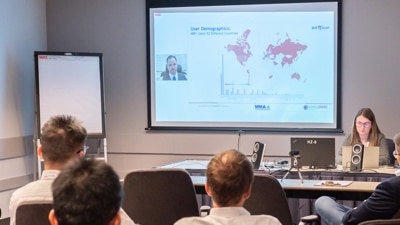

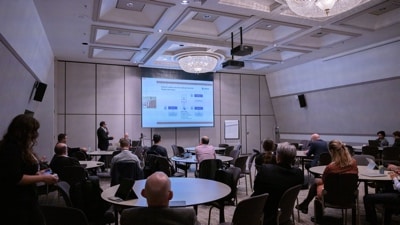
The final presentations for the openBIM Awards Program 2022 also took place in a hybrid format. A different elite jury was put in place for each category, who watched and deliberated live in Montreal. The winners were announced on the evening of 20 October at the first live Awards Ceremony for 3 years! From the 21 finalists who presented, 9 were crowned as category Winners with 3 Special Mentions also awarded. The full list of the winners and special mentions can be found here.
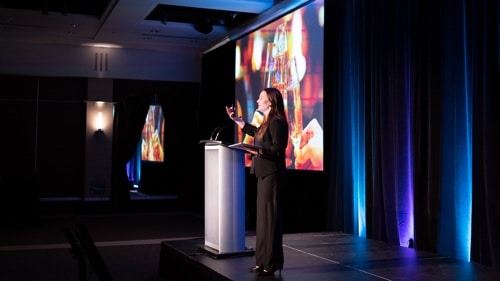

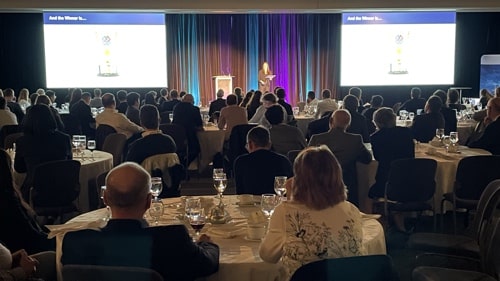


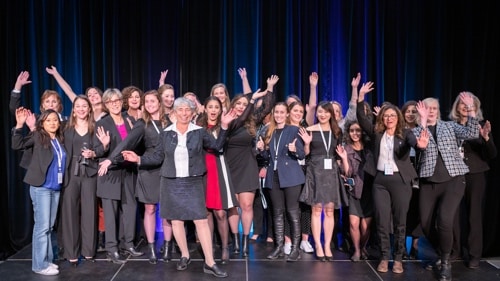
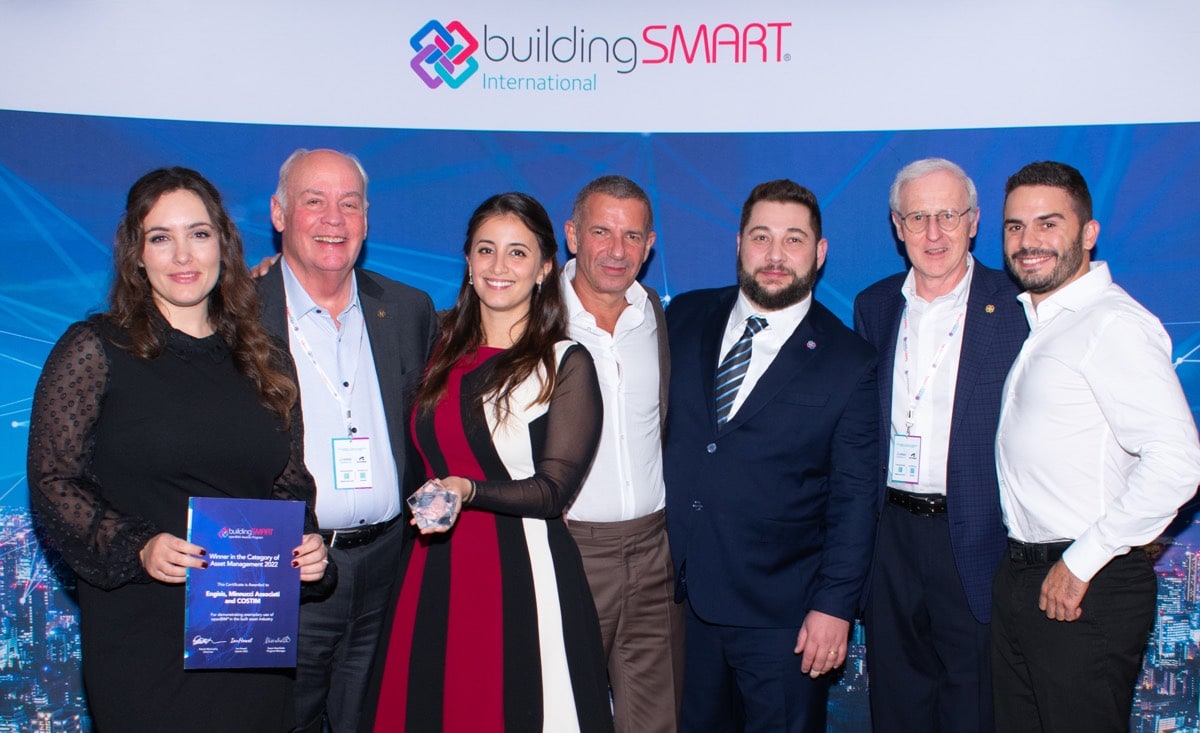



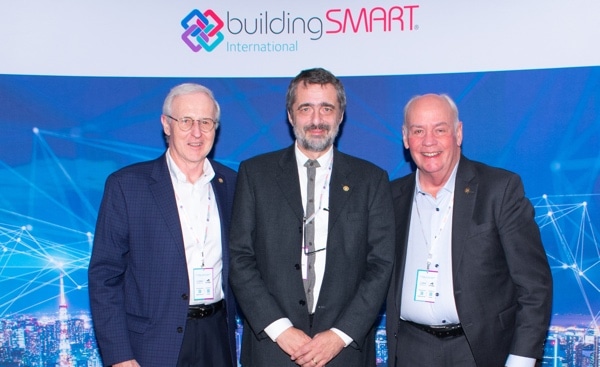
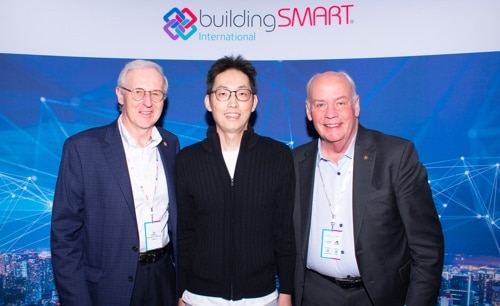
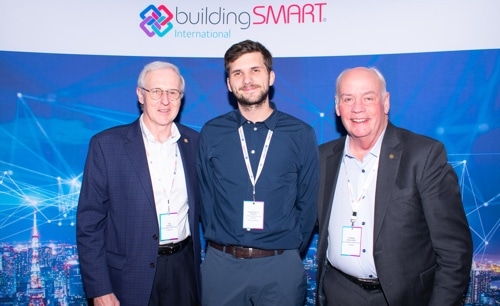
Day Four - 21st October
The Closing Plenary
The closing plenary continues with the customary wrap-up, conclusions, and next steps, which are delivered by Room leaders on the final morning of the event. Richard Kelly hosted this final session, but prior to the Room updates, Ian Howell provided a closing presentation commending the Rooms and all the contributors. Ian reiterated that the wave of adoption is expected and this encourages future growth through the many activities, as end-users will need to be supported. Richard then gave some progress reports from the Rooms and showed some success stories amongst other calls for participation that will grow the standards needed to support the industry.


Arisca Droog from the Airport Room shared some progress on the “Entities Project,” which started with a redefinition of the project scope. They delivered a project proposal and a 1-pager. In 2021 the team took the list of entities at an airport and populated them in the bSDD. This included mapping these objects to IFC, and it was a successful pilot. Arisca also talked about the surveys they are undertaking, such as “Baggage Handling” and “Airport Specific Security Systems and Passenger Control” which provided very valuable input to the Room. They also want to add some of these results to the bSDD. It was reported there were over 50 responses globally for the baggage handling survey. Arisca also confirmed that the overlap with other rooms is very crucial, and collaboration is a huge takeaway from the Summit. Finally, it was acknowledged that they need to continue to explain the relevance of IFC to the aviation industry.
David Ivey from the Building Room provided a conclusion by updating on the Room activities and all current projects. He also talked about how the bSI Process works and how ideas filter into the Room. David discussed how “openBIM factory-based planning” was an important presentation as it showed some real examples using openBIM models/digital twins applied to factories. There was also an asset management and handover workshop that featured both in person and virtual speakers. This included the repackaging of COBie into a new standard. There was a joint session “Building Energy Modelling” which aims to develop a roadmap. One of the big takeaways is the need for people to start talking to one another and to utilize all expertise across the community.
Ken Endo from the Construction Room talked about the four presentations from the Summit, which drove the topic of conversations in the room, including an update from Veljko Janjic of Bexel Consulting. Ken reflected on the different types of discussions within the room, spanning technical and domain experts. He talked about the Construction Room being use case focused, and the benefits of cross-collaboration with other Rooms. There was also a description and outline of the differing levels of BIM, from 3D right the way to 6D (and beyond). There was also an acknowledgment of the benefits of the Use Case Management Service (UCM) from bSI as a way of storing best practice. Ken highlighted the benefit of exchanging news and updates from bSI as a way of staying connected as a Chapter and a Room. There is currently space on the Steering Committee for any new applicants wishing to join.
Jim Plume provided a summary from the Infrastructure Room, which included an update to the roadmap comprised of five workshops, some virtual and some in person, and they extended the ideas and feedback from these which was collated at the event. The Infra team has been successful in continuing a lot of meetings outside of the Summit timeframe. There was also a panel session in which client commitments were reinforced, a joint workshop with the Building Room, German Chapter updates for Infra projects, and an IFC Tunnel project update, which Jim stated had been going very well. The project itself has created its schema, documentation, and planned extensions to IFC 4.4. There was also a comment at the end that the Infra team is looking forward to being in Rome in six months’ time.
Michel Bohren represented the Product Room and reflected on a good week in Montreal, saying that it was hard to maintain progress during COVID. There is a plan to get a mandate from the community in their repositioning of the Product Room. They had previously asked for industry input about what they hoped the Product Room should be. Some of the findings include the need for a systems approach, APIs, and access to built assets. Michel stated that the main outcome from this week was a series of workshops, and these produced 5 activity “clusters,” including definitions and explanations, referencing (product) data, governance, data exchange / open APIs, and process maps and use cases. As a result, the Room developed a draft Roadmap with these clusters as inputs with various goals outlined. This is very exciting news, and everyone looks forward to seeing the progress made when next convening in Rome.
Winfried Stix was next from the Railway Room, with the main message being that IFC 4.3 needs implementation. They were very focused on this during the event, making it clear by looking through the project phases. Phase 1 was the requirements analysis, which was cited as the hardest part. This phase was all about asking people what they wanted as their specific requirements, with the goal to support rail infrastructure managers around the world. Phase 2 was to develop the IFC 4.3 standard. This is where they are at today and it has been a huge achievement to date. However, they designed phase 3 – applying this standard to software vendors – as an additional step. This will help to support end users when the standard is published (the wave of adoption), and has been the focus of the Room at the Summit. There were also more requests for cross-collaboration with other Rooms.
Nick Nisbet from the Steering Committee of the Regulatory Room was next, providing the update on the very good progress of the Room. Nick expressed that the Room needs to be the voice of the customers regarding what the requirements are. They have had success with their open houses, surveys, and momentum from the Summits. Two projects are now underway, one being “A guidance on openBIM for Regulators”, which is an important project for the community as it allows materials to guide those who set and manage regulations. There is also good news that approvals are again being issued against IFC models, which is very significant. Another big announcement was that IFC is now mandatory in Finland, paving the way for how regulations related to IFC might be made mandatory for other governments and countries alike. The promise of significant progress on the roadmap is a testament to their ambition.
Trinidad Chardin-Segui from the Sustainable Energy Management Room, the newest Room and still in its early stages of development, gave her feedback from the week. The Room benefitted from multiple joint sessions, as well as other open discussions. The plan for the Room is now to finish the activity proposal, which they hope to present in Rome and find more alignment with the Building Energy Modelling initiative.
Greg Schleusner, leader of the Technical Room, provided the final review from the Summit, reflecting on some of the technical topics covered. These included ‘IFC Today’, walking through the historical evolution of IFC right up to what it looks like today. Then, by thinking forward to IFC 5, the team looked ahead and had different possibilities and variations of what this version might be able to solve. The Room invited some of the major authoring vendors to talk about some of the implementation and data exchanges for the ECS model in their solutions. There was also a validation workshop which was hands-on, as was a similar workshop for the bSDD. Another session that complimented this was for maintaining and managing data in the bSDD with other vendors (such as ACCA and Cobuilder). For Rome, the Room has outlined the goals for IFC 5 and what this will solve for other rooms and to start prototyping ECS concepts.
All Room summaries and conclusions had common themes: the need for more cross-collaboration amongst Rooms and the desire to be in Rome in 2023.
The event was concluded with a sign-off from Richard Kelly, Dan Little, and Erik Poirier. The audience also heard from Anna Moreno and Lorenzo Nissim, President and Vice President of IBIMI (buildingSMART Italy), who will be the Chapter hosting the next Summit, 26-30 March 2023, in Rome.

